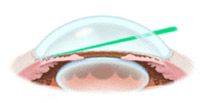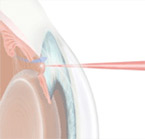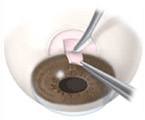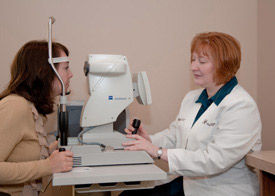Our Services: Treatment
Our Services: Treatment
Glaucoma can be treated with eye drops, laser surgery or incisional surgery to lower your eye pressure. If the doctor is suggesting laser or incisional surgery, here is some important information.
 Selective laser trabeculoplasty (SLT):
Selective laser trabeculoplasty (SLT):
The SLT procedure is performed to improve the outflow of fluid through the drain of the eye, therefore lowering the eye pressure. It is not painful, is done right in the office, and takes just a few minutes. Approximately 30 to 60 minutes prior to the laser, an eye drop is put into the eye to decrease the risk of a pressure rise within the first hour of the procedure. A lens is placed onto the eye and the laser is aimed at the drainage system (trabecular meshwork) of the eye. Your activities are not limited afterwards, as they would be after incisional surgery. The laser can be used alone to treat glaucoma or it can act in addition to your eye drops. It can work to lower your pressure as well as an eye drop, and it may be repeatable though its effects may diminish over time (several years). One eye is done at a time though both eyes may require the laser treatment. You will be on a short course of anti-inflammatory eye drops following the laser.
 Laser Peripheral Iridotomy (LPI):
Laser Peripheral Iridotomy (LPI):
The LPI procedure is done for closed-angle glaucoma, or in people who have "narrow angles" at the front of their eye. It is performed to prevent or treat an attack of glaucoma, which can cause redness, eye pain, haloes around lights and may eventually lead to loss of vision. A lens is placed on the eye and the laser is used to make a small hole (much smaller than your pupil) in the peripheral iris (colored part of the eye). This small hole allows fluid to pass within the eye and sometimes improves the "narrow" appearance of the front of the eye. You will be on a short course of anti-inflammatory eye drops following the laser.
 Glaucoma (filtering) surgery:
Glaucoma (filtering) surgery:
Incisional glaucoma surgery, or "filtering" surgery, refers to either trabeculectomy or a tube shunt procedure. Either type is done on an outpatient basis either at a hospital or surgery center facility. Both of these procedures can potentially lower your eye pressure a great deal and place your glaucoma under better control, reducing the risk for blindness.
A trabeculectomy involves making a "trap door" out of the wall of the eye, thus making a new drain in your eye, and allowing another place for fluid to drain from your eye, reducing the eye pressure. The result is a blister or a "bleb" on the surface of the eye, located under your upper eyelid.
A tube shunt is a device that is sewn onto the wall of the eye, with the tube entering the eye to "shunt" fluid from inside the eye to the plate on the surface of the eye. The plate is covered by your own tissue (conjunctiva) and, in most cases, is normally not visible.
Cataract surgery:
"Cataract" refers to a clouding of the natural lens in your eye. It is usually aged-related, but could also be due to medications, diabetes, inflammation or previous trauma. If a cataract has caused blurring or doubling of your vision, glare, difficulty driving at night or has stopped you from doing activities you enjoy, it may be time to consider cataract surgery to remove this cloudy lens.
Cataract surgery is done on an outpatient basis. You will be undergoing light anesthesia ("twilight" sleep) to keep you comfortable. A numbing injection or eye drop will be placed on your eye to keep you pain-free during the procedure. Your cloudy lens is removed through a small incision with a special ultrasonic device to break up the cataract. Once the cloudy lens is removed, a clear artificial lens is placed into the eye. This allows light that enters the eye to focus on the retina, creating a clearer image.
 |
The new artificial lens is selected by your surgeon based on measurements of your eye done before the surgery. We will ask you for your input and goals for your life after cataract surgery to make sure we are meeting your visual needs to the best of our ability. Our goal is to give you clearer vision in the distance, usually without glasses correction, but reading glasses may still be required for near work. A different type of artificial lens (a "Toric" lens) can also be used to correct corneal astigmatism at the time of cataract surgery for patients who have a high degree of corneal astigmatism and who have a visually-significant cataract.